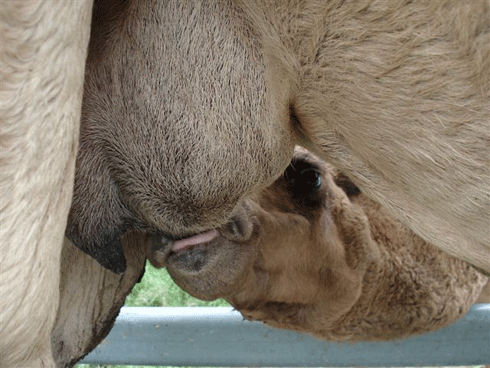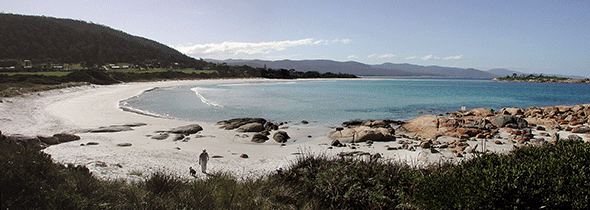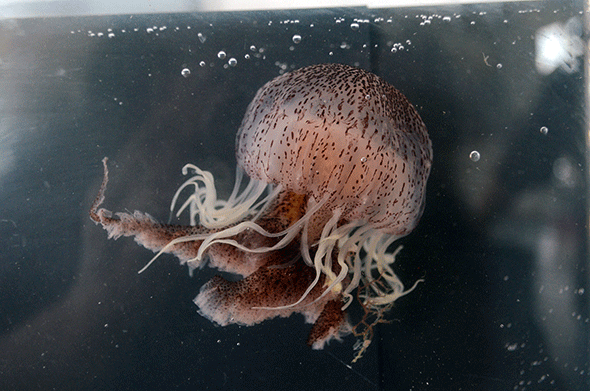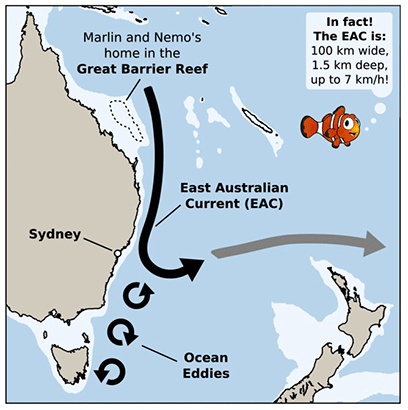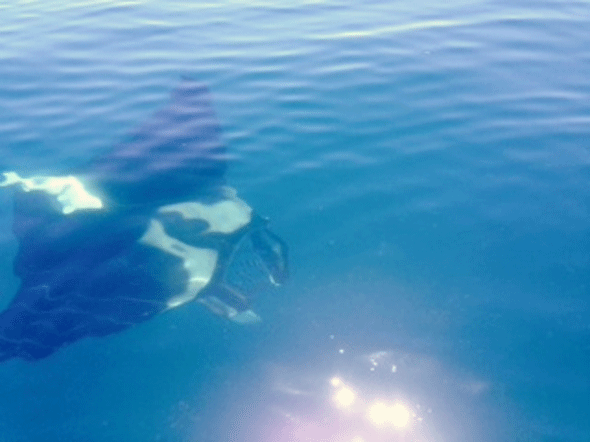
|
Published: 30 July 2012
Joining the camel train
Feral camels cause significant environmental damage in Australia’s arid interior. Demand for exported camel meat is strong, but getting culled wild camel meat to market is difficult. Rachel Sullivan finds renewed interest in managing camels as fenced livestock.
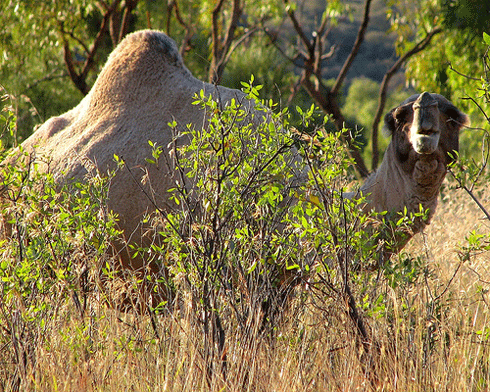
|
|
A feral camel at Uluru-Kata Tjuta National Park (the Olgas) in the Northern Territory.
Credit:
Susan Renee
.
Licensed under a Creative Commons Attribution Non-Commercial, No-Derivatives License
|
Camels have been a part of the Australian landscape since the early 19th century, but until relatively recently, they attracted little attention. Then, in the late 1990s, aerial surveys showed a massive build up of camel numbers, with populations doubling every nine years or so.
There are now an estimated 750,000 camels roaming Australia’s arid interior, moving into more remote areas and encroaching on pastoral land. They are regarded as a significant pest across more than three
Individual camels can travel up to 70 kilometres in a day and range over thousands of hectares each year, affecting fragile arid wetlands and waterholes, and damaging tree and shrub species such as the quandong: a bush tucker fruit that is threatened with localised extinction.
During the millennium drought, desperate for water, feral camels mobbed together: destroying water pipeline infrastructure and damaging fencelines and Aboriginal settlements. Camels currently cause around $10 million of damage per year – if left unchecked, their impact is expected to grow as climate change brings drier and hotter periods to the rangelands.
In response, the Australian Feral Camel Management Project (AFCMP) is running a program that includes culling and the development of commercial use of camels through, for example, export of camel meat from culled wild camels and raising camels as livestock.
However, the program has drawn some local and international condemnation. Some argue that camels could form the foundation of a whole new industry and build a vibrant arid economy; not only by supplying meat, livestock and other products for export, but also by helping weed management.
Export challenges
Killing camels for export began in Alice Springs in the 1980s. But, according to the Department of Agriculture, Fisheries and Forestry (DAFF), the industry has struggled with the high costs of working in remote environments and the need to transport live camels over long distance to abattoirs. This limits processing infrastructure and causes irregularity in camel supply and fragmented, inadequate marketing of camel meat.
Australia currently exports camel meat to a range of markets, including the United States, Canada and the European Union. Live camel meat is exported from Australia to seven countries in Asia and the Middle East, and demand is increasing. The Samex Australian Meat Company in Peterborough, South Australia – one of two Australian halal-certified camel abattoirs – beginning processing camel meat for export in April 2012. Meramist, a Caboolture (Queensland) abattoir, can’t keep up with demand.
‘We’re lucky to fulfil 50 per cent of our existing market requirements and are not expanding our business, despite receiving eight to ten calls or emails a week from prospective customers seeking camel meat supplies,’ says Mike Eathorne, Meramist Managing Director.
‘In order to create a long-term viable business we need camels behind wire,’ he explains. ‘We’re slowly getting the message through to farmers and graziers that camels have a value.’
‘You can’t rely on mustering feral herds, because you’re too exposed to the weather. In wet conditions the herds scatter, making them harder to muster and you can’t find 200–300 in a mob. But, when the water supplies dry up, they mob up, making them easier and more efficient to catch.’
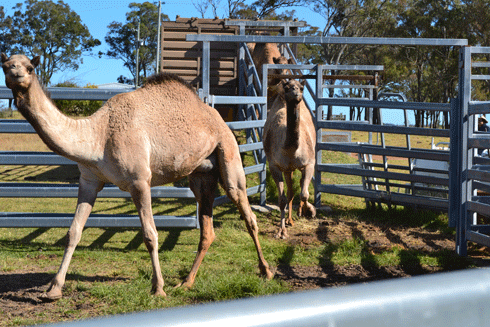
|
|
On Bindanoon, a grazing property 170 kilometres northwest of Brisbane, camels are co-grazed with cattle.
Credit:
Debbie Corbett
|
Camel expert Philip Gee agrees. He supports landholders making decisions they believe necessary to maintain the viability of their farming enterprises, in the context of increasing food security issues globally. But, he would like to see a shift in focus of some landholders: away from culling and towards managing camels as a domestic resource to produce clean, green and healthy meat.
‘We need to better utilise camels as a resource and ultimately move to a situation where camels are raised behind wire,’ he says. ‘This will allow us to destock the country during drought periods to prevent damage, which we can’t do with feral populations.
Mr Gee believes there needs to be a managed transition from feral to managed camel populations.
‘We have a large reserve of feral camels that need to be largely removed from the landscape, we have thousands of unemployed people in remote communities, and we have two camel abattoirs with demand for exports that can’t be met.
‘Mustering the feral herd will benefit the environment and create jobs for remote communities, while also building the supply chains to the two abattoirs in this area.
‘Mustered feral camel sales create a greater economy than the few hundred dollars their sale to the abattoir will bring. There is also the decent economy created right along the supply chain, from employment and enterprise generation in remote communities through to shipping and trucking, supplying feed, maintenance services and abattoir employment; and at the other end, the economy generated through marketing and retail sales.’
Lauren Brisbane, Chair of the Australian Camel Industry Association, also believes that we need to take a whole-of-economy point of view.
‘Camels that cause environmental damage need to be removed from inaccessible sites where the pastoralists and indigenous communities agree with culling,’ she says.
‘But, where possible, it makes economic sense to remove the camels – through partnerships with indigenous communities – for sale or slaughter. It makes better economic sense for Australia and puts money back into the local economies.’
Jan Ferguson is Managing Director of Ninti One Limited, the organisation responsible for AFCMP.
‘We are going to lose biodiversity if camel numbers aren’t controlled. This is the first time removal of a feral pest has been undertaken on this scale,’ she says, adding that culling is a part of a broader program of control measures.
‘The AFCMP, a collaboration between 19 partners, has for the first time implemented nationally agreed, safe operating procedures for handling and removing camels and humane treatment of the animals.’
While the AFCMP has involved culling large numbers of camels, Ms Ferguson says that during the past three years, the project has also contributed to the removal of 15,000 camels for commercial use.
‘Earlier this year with our support, camels mustered and loaded on Anangu Pitjantjatjara Yankunytjatjara (APY) Aboriginal lands in Central Australia were transported to the [Meramist] abattoir in Queensland. [This signalled] the recommencement of a trade that may provide employment and income for Aboriginal communities and help control Australia’s feral camel population.
‘We have been working closely with our partners from the Central Land Council and traditional owners on APY lands to support important on-ground work.’
Ms Ferguson says that this work has included:
-
constructing yards and diversionary waterpoints to build the foundation for commercial use
-
encouraging employment for mustering teams
-
undertaking firearm training to allow remote communities to manage local feral camel problems
-
developing butchery skills to encourage subsistence use of camel meat to improve access to cheap fresh meat in remote communities.
Weed control
In Queensland, about 10,000 camels are managed in small herds, helping to control weeds such as prickly acacia, prickly pear, Paterson’s curse and Parkinsonia. Camels may also increase beef production, by sharing a beneficial gut bacteria with cattle.
Their ‘talents’ were showcased at a camel farming field day in July 2011 at Bindanoon – a grazing property 170 kilometres northwest of Brisbane – attracting interest from all over the state, despite heavy rain.
Debbie Corbett owns Bindanoon, which co-grazes cattle and camels. She believes we need to look at camels as a resource, not a problem.
‘Our camels are disease free and genetically pure – culling them is just wasting this amazing resource,’ she says.
‘We had heard that camels were great at controlling weeds and brought in our first load of camels about six years ago, because we had prickly pear and eucalypt regrowth. They decimated the prickly pear – they love it and get fat on it– and nibbled down eucalypt suckers that would otherwise have had to be sprayed.’
DAFF agrees that camels have been used successfully by some commercial enterprises to control woody weeds such as Parkinsonia 1 . But, they caution that more research is needed in this area, because of the risk of weeds spreading through camel dung and because camels also graze native vegetation.
‘There are many climatic zones and vegetation types where camels can exist, which means that advice for one region is not going to necessarily apply to another,’ a statement from DAFF notes.
‘In central Australia, where the camel is a pest, studies have listed 200 species of native vegetation that camels will graze, so if the preference is to graze natives before weeds, it could cause a problem.’
Mrs Corbett says that despite their difficult reputations, once camels have access to food and water, they are extremely gentle animals: so much so that she can milk wild-caught females just six weeks after their arrival.
She uses the milk to make creams, lotions and soaps that are sold online and through the local market.
‘Camel milk is antibacterial; it’s amazingly good at treating burns. It is currently being studied in the United States for its beneficial effects on people with autism and with diabetes, because the milk has a protein that is very similar to insulin.
‘Camels can even boost cattle growth rates, by sharing a gut bacterium with the cattle that helps them convert feed to energy more efficiently.
‘We have noted that when ingested by our cattle, this microbe stimulates their rumen. The cattle appear to eat a lot more of the unpalatable dry vegetation, aiding in approximately 10 per cent weight gain during drought conditions.
‘And, when our weaner calves are put in pens where they share feed and water with camels, they do much better. Normally, three weeks after being taken away from their mums, they look very thin and ‘tucked up’; but, when they’re with camels, they keep looking fat and healthy.’
Despite anecdotal evidence to the contrary, a 2001 Rural Industries Research and Development Corporation report concluded there was no change in steer performance from co-grazing with camels.
Dr Rafat Al Jassim, Senior Lecturer from the School of Agriculture and Food Sciences at the University of Queensland, is currently re-examining the benefits of co-grazing and trying to explain why cattle perform better when co-grazed with camels.
‘Of course, this is a claim yet to be proved,’ he says. ‘In our research, we are investigating this by testing the biochemical characteristics of rumen fluids from cattle grazed alone and cattle grazed with camels. We are also [comparing] the microbial communities in the two groups of animals.’
‘For pastoralists, running camels [for meat] provides another income stream,’ says Mrs Corbett.
‘But, that’s only the start of their benefits. People are keen to learn more, if the response to the recent field day is anything to go by,’ she says.
1 Weeds Australia, Parkinsonia management, http://www.weeds.org.au/docs/Parkinsonia_Mgmnt-4.pdf


